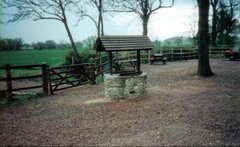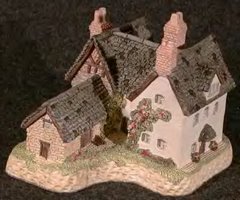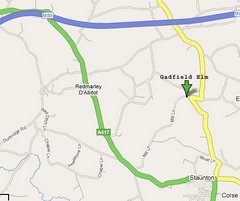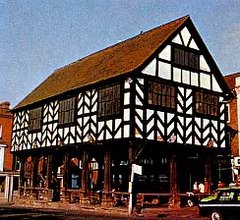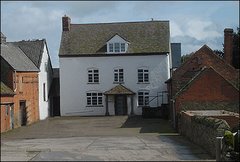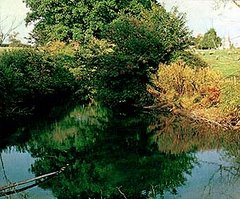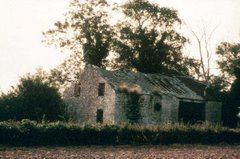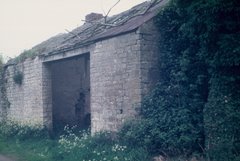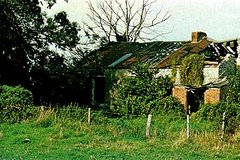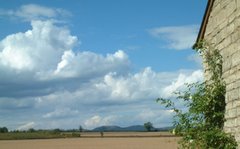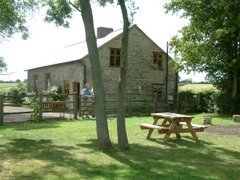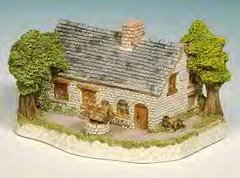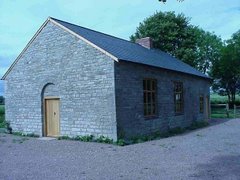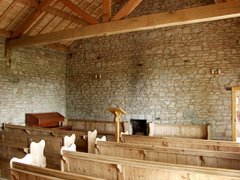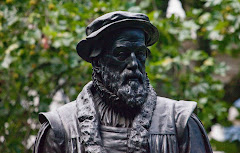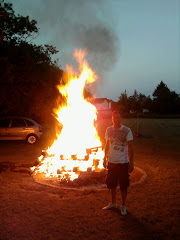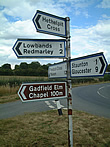
My name is Andrew Mason. I served as Bishop of the Redditch ward (7 years 50 weeks and 4 days, not that I was counting!) from 2002 to 2010. I am best described as an amateur historian who is an enthusiastic supporter/promoter of local LDS church history in the three counties (Gloucestershire, Herefordshire and Worcestershire, which are all in England, not Wales).
**NEWS**
New film released 2019:
I am very interested in LDS church history sites in the UK, and especially those of Benbow's farm and Gadfield Elm, and several other sites of interest in the Herefordshire, Gloucestershire and Worcestershire areas. For any "foreign" visitors please note that these places are definitely in England, I'm getting a bit fed up with these places being described as being in Wales, not that I've got anything against Wales or the Welsh people, its a matter of accuracy and geography, the Welsh border is probably less than 25 miles away (as the crow flies). Wales has it's own church history stories to tell of missionary work (look up Dan Jones) and conversions and I leave it up to them to write their own blog!
I played a very minor part in the actual restoration of the Gadfield Elm chapel, and the maintenance of the grounds of both sites (Gadfield Elm and Benbow's pond). I did however offer much moral support to the artisans who sweated more than a little blood, and I also spread the word as far as I could to solicit donations towards the work! My brother David Mason, currently Bishop of the Gloucester Ward, has a contract with the church to maintain the grounds on both sites, and this picture does not do justice to the standards in which the grounds are usually maintained.
I like the changes made to both sites over the last few years, both are very pleasant places to visit, peace and quiet abound, both sites are far enough away from major roads so that traffic noise is at a bare minimum most of the time, except for the occasional tractor of course. Visitors are free to sit and think, to contemplate whatever is important to them, or to just sit and enjoy the beauty and the peace and quiet of the countryside around them. Both are beautiful sites for picnics or even a BBQ (at Gadfield Elm only), for Sunday afternoon outings, or for ward or family activities. Since the chapel at Gadfield Elm was finished (and even a couple of times before that) it has been used for many different youth and YSA firesides, various ward social events, stake events and even a Stake High Priest Quorum meeting. Large and small groups can often be found camping in the field next to the little chapel. 2010 will be the fourth visit of the Redditch ward Faith in God children, when they will be taking part in their annual day camp.
Visitors should note that there are no public facilities at all at Benbows pond, and only the bare minimum at Gadfield Elm (and no drinking water). You should follow the country code if you visit either place - take nothing but photographs, leave nothing but footsteps and kill nothing but time!
Visitors are encouraged to sign the visitors book at Gadfield Elm so that visitor numbers can be monitored.
I collect articles and photographs of interest concerning these sites, and in Oct 2006 I acquired a number of slides of church history sites across the UK. I believe that these are exact duplicates (or even the originals) of pictures used in the December 1979 Ensign (I have 27 slides out of 36 pictures in the article). I don't think these have any particular monetary or historical value, except that I now have several pictures of Gadfield Elm (dated 1979 I presume because of the Ensign article when it was in a really poor state of repair, and well before it was purchased by the Gadfield Elm Trust. I have pictures of Benbow's pond before the "health and safety" brigade had it fenced off, and a picture of Hawcross pool that leads me to believe that it was once quite possible, albeit a very long time ago, to have been deep enough to baptise in. Currently the "pool" is not much more than a well overgrown muddy soggy mess. When I visited these sites in June 2008 I saw that there was a lot of water in both ponds, and there was so much at Benbows farm that the fence was about 6 foot into the pond, and I can assure you the fence wasn't erected like that!
Go to http://www.lds.org/ensign/1979/12/the-way-it-looks-today-a-camera-tour-of-church-history-sites-in-great-britain?lang=eng to see the picture article for yourselves (Magazines, Ensign, 1979, December).
Also look at http://www.lds.org/?lang=eng&country=gb where you can find the official UK church web site where you can find current content.
Another interest I have is the film A Story of Strength, which I think was made in the late 1980's. I want to find out more about this film, which is now "out of print" and I understand that the church will not produce any more copies. I recently discovered the identity of the narrator, and I am hoping to meet him sometime. I know many of the extras, who were mostly local church members, one of whom is my wife Sue Walden (the film was made before we were married), others include my mother Jennifer Mason, and my brother David Mason. The "extras" came from many local units which included; Cheltenham, Gloucester, Hereford, Worcester, Stroud and Yate, every time I watch it I try to name someone. Some of my questions about this film are: Why was it made? Who made it? What was the target audience? I might even one day make a list of those who appear in it. My wife has her own special story to tell of the impact it had upon her, when her finances were not in a particularly good position and maybe one day I will get her to write it down.
2016 - I've just discovered that somebody has posted the film 'A Story of Strength' on YouTube, please go to the following link to watch the film (sorry it is not a hyperlink but you should be able to copy and paste the text): https://www.youtube.com/watch?v=CPF7R3ejBa0 or try this link:
A Story of Strength (1987)
I sometimes wonder if I am a bit of a nerd when it comes to these things? I don't care! - Actually I do care rather a lot, and I get frustrated when others dismiss this part of our local British church history with hardly a passing thought. Let me make it clear... Gadfield Elm chapel was the first chapel owned by the church anywhere in the world. I know that it was not built by LDS people, but it was still fairly new when the deeds were given to Wilford Woodruff for the church, and the only other church owned property that I know of at that time was the Kirtland Temple. Pres Hinckley said during the dedicatory service of the chapel in May 2004 that "this is the oldest chapel we have anywhere in the world... This chapel was in use by the church before we had built anything in America".
Another fact is that the Gadfield Elm chapel is the only official church history site outside of North America.
Also lets remember that there are many many thousands of "American" LDS people whose ancestry is firmly British, and many who can trace their ancestors to members of the United Brethren who joined the church and emigrated to Zion.
During the first ever visit of the Tabernacle choir to England (1955, I was just 1 year old so I don't remember it!!!!) the choir members were asked to stand if their ancestors were from Great Britain and apparently all but three stood up!
Following this strong line of British LDS church history we also need to remember that the Preston Ward in Lancashire, is the oldest continuous unit of the church anywhere in the world, and that's another British fact that (hopefully) will never ever be overturned. Another long standing church unit in the UK is Kidderminster, which is only about 40 miles from Gadfield Elm.
At some point I might ramble on about a few other items of interest such as:
- British LDS authors
- British LDS musicians
- British LDS General Authorities
- A documentary film called "The Kingdom and the Crown" which is nothing to do with the author and General Authority Elder Gerald Lund, but rather a film made by BYU and put on video c1988. I recently viewed this film on BYU TV and quite frankly it is abysmal, I think that's part of the reason why "A Story of Strength" was made by the church. In fact The Kingdom and the Crown is so bad that maybe I will not bother to say any more except if you have access to BYU TV you might one day get the chance to see it for yourself and then you can make up your own mind.
- I have another film of British saints called "Mormons Fact and Fantasy", I actually need someone with a 16mm projector to show it to me as I only recall ever seen it once, and as far as I can recall it must have been made at least 25 years ago, and possibly a little longer than that. Also it is the only copy that I've been able to locate in the UK, but I'm just as sure that there will be a few ward libraries that probably still have a copy in the back of an old dusty cupboard, and probably a projector too, but I can't locate them! Update June 2008... I found someone with a copy on DVD, I didn't ask how he got it, but he was kind enough to make a copy for me. Having viewed it I think the most important thing in it is the people I know, some of whom have passed on. It seems that it was one film in a set of similar films made in various countries around the world to show that LDS people exist outside of the USA and that wherever LDS people exist that we are we are all "normal"! Also another fact I discovered is that this was just one of a series of films made around the world so that other people and cultures could discover that 'Mormons' around the world are 'normal'!
2016 - I've just found that the film 'Mormons Fact and Fantasy' has been published on YouTube... everything comes to he who waits! Please go to: https://youtu.be/1VrQaxNp-fs (sorry it is not a hyperlink, but you can copy and paste the text). or try this link:
- The personal relationships of my family with a (now very very) small number of American LDS servicemen and their families, who were briefly based in Cheltenham during the 2nd world war - including Ray J. Hermansen and the late Bill Overly, and the missionary who was responsible for baptising my father, Hal McKewan. A few years ago Hal and Bill, who lived somewhat near each other in SLC, discovered through their casual acquaintance at a local gym that they both knew our family, and through Bill we were later able to meet Hal. Over a number of years we have met and made friends with many American Airforce personnel stationed at Little Rissington and Upper Heyford (both now closed) and some US government employees who worked at GCHQ in Cheltenham (secret spy listening base, but you can look it up on the internet!). I know that a lot of members of the Cheltenham ward have kept in touch with many of these "cousins" of ours. Through an unusual set of circumstances I actually met one person in the Boston temple a few years ago!
For some other personal Mason family insights please look up the October 1996 Ensign, and an article called "The Sisters of Cheltenham" written by my mother, Jennifer Middleton Mason, or view an exact copy of the text here on another of my blog sites...
http://sistersofcheltenham.blogspot.com/
I suppose that all in all I want to "promote" the British heritage of many of the early saints and pioneers, as well as creating a little record of our local history that others might find interesting.
I don't think I have anything new to add to what has already been written, it is certainly not my intention to become some kind of published author, nor is it my intention to publish a dissertation (just the ramblings of a simple soul) I just want people to come and enjoy our heritage and enjoy our wonderful and unique countryside. At this stage if anyone wants to know a little more about Gadfield Elm and Benbows Farm then just do a Google search. You might come across Ronan Head, he is an expert on a lot of things, and has a couple of really good articles already available on the Internet. For those who subscribe to the Ensign (in Britain) you will find the UK insert in the January 2007 issue has a great article by Ronan on Gadfield Elm.
If anyone wants to visit Benbow's pool, or Gadfield Elm, please feel free to respond to this blog (with a return e-mail address) and I will e-mail you directions, and will be pleased to offer any helpful advice on travel distances and routes etc. These places (Gadfield Elm and Benbows Farm) are unfortunately not clearly marked on most maps but they are close to Ledbury in Herefordshire (which is on every map), and if you have the right directions both sites can be visited, with a reasonable amount of time spent at both locations, in just a couple of hours, and with the right instructions they are fairly easy to find. I know several people who have tried to find these places and have been unsuccessful, but as I said above with the right instructions it is easy and I have recently added GPS coordinates for those who may have a GPS device available (see below).
As a rough guide to distances and travel times Ledbury is just over 1 hour from Birmingham, 3 hours from London, 1.5 hours from Stratford, 1.5 hours from Warwick, 2 hours from Oxford, 4 hours from York, 1.5 hours from Bristol, 1.5 hours from Cardiff (these are Microsoft Autoroute times, so you probably need to add another 30 minutes to most of them to allow for traffic and other road/driving conditions).
Ledbury is about equal distance from both the sites I am writing about, and it is a good stopping off point. It is a wonderful little town, and well worth a visit. The Baptist chapel still stands in the main street where Wilford Woodruff preached and then baptised 13 people, and somewhere in the town is the building where some of the early missionaries stayed for a while. The other reason to stop in Lebury is that there are no facilities of any sort at the Benbow Farm and as it is privately owned and the owners are not members of the church you should not try to visit the farmhouse, or disturb the owners, nor park in their yard! Facilities at Gadfield Elm are also limited, so if you need refreshments, toilets, shops, etc. you need to visit Ledbury and make a short stop. Toilets are found on the walking route up to the parish church. In the same lane there are two museums well worth visiting, as well as a Tea room, where you can get great refreshments, and a specialist chocolate shop! For the seriously hungry there is also a fish and chip shop in the lane so if you haven't tried English 'fish n'chips' this would be a good plaice (pun!) to try some! Cod and chips is my suggestion.
The parish church in Ledbury is well worth a visit. Here is a conundrum for you to solve... there is something odd about the parish church. What is it? To find the answer you will have to get close to the outside of the church to find out. Having found out what it is that is odd, can you say why it is this way? If you don't find an answer locally and are interested enough to want to know the answer please e-mail me!
As I continue to add to this blog from time to time I am aware that the expectations of some readers might not be fully met for some time, if this is the case for you then please feel free to post a response and I will reply to you.
If you search using a few different search engines there is actually a surprising amount of information on the Internet, try these URL's (but don't forget to come back here!):
http://ourfamilyheritage.blogspot.com/2006/11/united-brethren.html
http://www.cotswolds.info/worcestershire/oldest-mormon-chapel.shtml
http://deseretnews.com/dn/view/0,1249,595066022,00.html
http://www.bycommonconsent.com/2006/04/a-mormon-mecca-in-england/
http://www.centerplace.org/history/ts/v2n09.htm
http://speeches.byu.edu/reader/reader.php?id=1571
http://www.mormonhistoricsitesfoundation.org/publications/studies_fall2000/mhs1.2FaulringFall2000.pdf
you can buy a model of the chapel (see picture on the right) from the following website http://www.davidwinter.info/gadfieldelm.html
It is my intention at some point to put on the web a copy of all the pictures I have, but until then you can enjoy the few I have here, and do some Internet searches yourself as there are a few other pictures already out there.
Now to begin the story properly I need to take you back a long way...
The first real printing press was invented in 1440 by Gutenberg. This was the first printing press that was capable of printing books in large numbers because of the use of movable type. Gutenberg also published his own translation of the Bible, known as the Gutenburg Bible (in German I assume). What is significant is that the Bible was being printed in normal everyday languages (except English) that anyone could read, not just in Latin, Greek or Hebrew which could only be read by a few clerics and scholars.
If you find yourselves in Germany you can visit the Gutenburg printing museum in Mainz where he was born and lived - my wife and I went there in 2016.
A short while after the invention of the printing press came the reformers, many of whom gave their lives in order to preach the Gospel as they knew and understood it. Let me just mention very briefly just two of them.
Around 1530 William Tyndale published the first five books of the Old Testament in English, then around 1534 saw Martin Luther complete his translation of the Bible into German, the first time it had truly been made available to the people to read in their own language. One of Luther's hymns, "A Mighty Fortress is Our God" is in our current LDS hymnbook To digress from my story another author in our hymn book is Cardinal John Henry Newman who was recently (Sept 2010) beatified by the Pope in Cofton Park Birmingham as a step towards becoming a Catholic Saint... see hymn 97 Lead Kindly Light.
Around the same time as Luther published his Bible (1534) William Tyndale published the entire New Testament in English, and much of it, together with a great deal of his translation work on the Old Testament, was later used in the King James version of the Bible that we still use today. Please don't think that this was the only English translation, it is believed that from as early as the 1380's there were some other translations into English, but only a few copies were available, it wasn't until many years later that by virtue of the printing press they became available to almost everyone who could read (in several languages, not just English).
On a note of "local" interest (and that is what interests me, and why I'm rambling on in this blog) We believe that Tyndale was born in North Nibley, Gloucestershire, he later studied at Oxford and Cambridge before being forced to move to London, then abroad. He was employed as a tutor by the Walsh family between 1521-23 in Little Sodbury, Gloucestershire, which is about 40 miles south of Gadfield Elm.
While at Little Sodbury Tyndale preached in St. Adelines Church as well as in a common place called "Saint Austen’s Green" and debated with Catholic priests. The oldest Walsh child that he was tutoring was only six years old, so it is probable that Tyndale had much time for himself. It is possible, in fact, that he began his Bible translation here. Tyndale had seen that the only hope for England was that the Scriptures be made available in the common language, and it was probably at Little Sodbury that he determined to dedicate his life to that task. One day during a discussion with Tyndale, a priest exclaimed, "We are better without God’s laws than the Pope’s." Hearing that, Tyndale boldly exclaimed: "I defy the Pope and all his laws. If God spare my life, ere many years I will cause a boy that driveth a plough shall know more of the Scriptures than thou doest." To the fulfillment of this noble purpose he dedicated his life, willingly suffering great privations, forgoing the joys of marriage and a settled family life, living like a hunted animal, for the sake of endowing his beloved people with the eternal Word of God. To translate the Bible into English was illegal at that time in England, and Tyndale was forced to go to Europe to do the work.
On a hill near North Nibley and Wooton-under-Edge, Gloucestershire, there is a 111 foot monument to Tyndale which can be clearly seen from a long stretch of the M5 motorway near the Michaelwood services and junction 14. I have not visited it for at least 10 years but it was certainly possible to climb the inside of the monument to a viewing area, where the views of the Cotswolds, the Severn Valley, the Severn bridges and the Welsh mountains can only be described as spectacular. A key is required which can be borrowed locally from a cottage, though I can't remember exactly where it is, but there used to be a notice at the bottom of the hill with instructions. Please take a look at this article:
http://www.timetravel-britain.com/05/April/tyndale.shtml
See also a talk from the April 2010 General Conference by Elder D Todd Christofferson - The Blessing of Scripture:
http://www.lds.org/ensign/2010/05/the-blessing-of-scripture?lang=eng
I have also discovered that there is a statue to Tyndale on the Parliament side of the Thames. It is in a small park called Whitehall Park/Gardens, Victoria Embankment (near the junction with either Horseguards Avenue or Richmond Terrace) London WC2 (?)
Here is the inscription that is on it:
William Tyndale: First translator of the New Testament into English from the
Greek, born A.D. 1484, died a martyr at Vilvorde in Belgium, A.D. 1535.
‘Thy word is a lamp to my feet and a light to my path.’
‘The entrance of thy words giveth light.’
‘And this is the record that God has given to us eternal life and this life is in his son.’
The last words of William Tyndale were: ‘Lord, open the king of England’s eyes.’
Within a year of his death a Bible was placed in every parish church by the command of King Henry VIII.
Another interesting fact: It is estimated that 83% of what we read in the King James version of the Old Testament is the work of Tyndale, and 75% of the New Testament is also his work.
So, where do I go next, and how do I link the printing press in 1440, translations of the Bible by about 1534, and the events at Benbows farm and Gadfield Elm in 1840? Here I list some important events that are relevant to my story, or that may help you the reader to link events and timelines.
1440 First printing press with movable type
1530 First 5 books of the Old Testament translated - the Pentateuch
1534 New Testament published in English
1611 King James version of the Bible, in English
1776 4th July US Independence day
1805 23rd Dec Joseph Smith born
1820 Joseph Smith's first vision.
1830 6th April Church organised.
1830 United Brethren are formed by a breakaway group of Methodists.
1836 4th march - United Brethren purchased land for £25 to build their own chapel.
1836 27th March - Kirtland Temple dedicated
1837 Queen Victoria was crowned.
1837 20th July - first missionaries arrive in England.
1837 D&C 112 received on the same day that that the Gospel was first preached in England.
1837 30th July - first baptisms in Great Britain
1837 6th Aug Preston branch organised
1839 First missionaries sent to Scotland.
1840 Wilford Woodruff goes to the John Benbow farm and begins preaching the Gospel.
1840 All but one of the United Brethren join the church
1840 Chapel given to Wilford Woodruff and so it becomes the first LDS chapel in the world.
1840 The Book of Mormon and a hymn book were printed in England, funded in large part by John Benbow and Thomas Kington.
1840 Eight Apostles in England at the same time - Brigham Young, Wilford Woodruff, John Taylor, Willard Richards, Heber C. Kimball, George A. Smith, Parley P. Pratt & Orson Pratt (there were only eight Apostles serving in the Quorum of Twelve at this time).
1840 First 41 emigrants left Liverpool
1841 Queen Victoria and Prince Albert presented with copies of the Book of Mormon
1842 Gadfield Elm Chapel sold to fund emigration.
1863 Charles Dickens visits the chartered ship Amazon in London, and records his astonishment at the way in which the saints had organised themselves (see The Uncommercial Traveller).
1874 John Benbow dies in Provo, Utah
1906 Joseph F. Smith visits London during his visit to Europe (first by a prophet)
1955 First Tabernacle Choir visit to Great Britain
1958 London Temple dedicated
1994 12th October - Gadfield Elm Trust formed with the aim to purchase the building at auction, then restore it.
1998 Preston Temple dedication
1994-2000 Restoration of the Gadfiled Elm chapel, and landscaping of the grounds
2000 23rd March - Easter Sunday, Chapel dedicated by Elder Jeffrey R Holland (Sis Holland is a decendant of the Benbow family).
2004 Chapel deeds given to the church, and re-dedicated by President Gordon B Hinckley.
Other interesting dates(?)
1987 Model of Benbows farm on sale
2006 Model of Gadfield Elm on sale
2008 Osmonds visit Gadfield Elm
to be continued...
Items to add:
Better links...
Written Directions...
Maps...
More pictures...
Contact information...
Missionary couples work part-time at Gadfield Elm:-
International dialing code +44 1452 840576
UK dialing code 01452 840576
or email: GadfieldElm@CheltenhamStake.net
Address: Mill Lane, Staunton, Gloucestershire, GL19 3PB
Sat Nav - if you use the postcode it will get you into Mill Lane without any difficulty, though if you are at the wrong end it is about a mile along the lane, if you are at the right end it is a couple of hundred yards, either way you will easily find it as the chapel stands alone by the side of the road and can't be confused with other buildings/properties.
GPS coordinates: see the pictures for the GPS coordinates I picked up from Google Earth and used in my Tom Tom. Someone else gave me them to me in a slightly different format from their GPS device, so I don't know if different GPS devices work slightly differently, but here they are:
Benbow Farm Pond is: N 52 deg 6.328’ W 2 deg 28.782’
Post Code: HR8 1HL -or- HR81HL (no space in the post code).
Gadfield Elm Chapel is: N 51 deg 58.766’ W 2 deg 18.910’
Post Code: GL19 3PA -or- GL193PA (no space in the post code).
If you are near Tewkesbury and want lunch or dinner try the best fish and chips around... Abbey Fryer Fish and Chip shop at: N 51 Deg 59.573’ W 2 deg 9.355’ and if you have the time explore the town center a little, and don't miss the church which is the 2nd largest parish church in England and has probably the largest Romanesque crossing tower in Europe. Tewkesbury is also famous for the little lanes and alleyways between the buildings.
I need to add some more pictures... 4 new pictures from 1978-81 (found July 2007).
Last update August 2019
| Provided by website hit counters website. |


